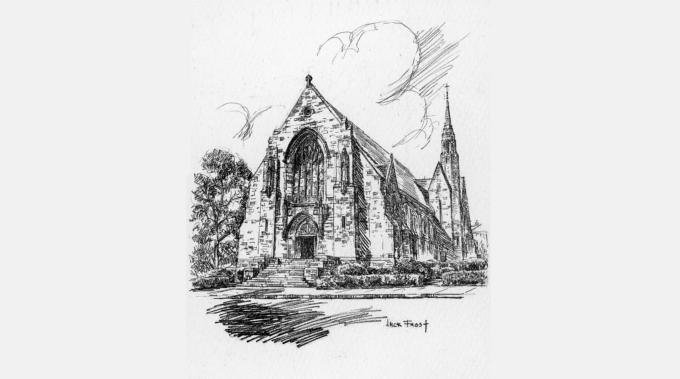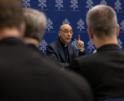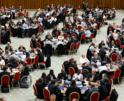
Culture
Friday, July 31, marks the Memorial of St. Ignatius of Loyola, the founder of the Society of Jesus. In honor of the occasion, and in thanksgiving for the immeasurable contributions of the Jesuits to the Archdiocese of Boston, the following is a brief history of his life and legacy.
St. Ignatius of Loyola was born at Casa Torre of Loyola, Spain, in 1491. The youngest of the 13 children of Beltran Yanez de Onaz and Maria Saenz de Liconia, he was baptized Inigo, a Basque name meaning "my little one," in the Church of St. Sebastian. After 1537, he also went by the Latinized "Ignatius," especially in official documents. Throughout early adulthood, St. Ignatius served the Spanish King in the military, until May 20, 1521, when he was wounded by a cannon shot defending the castle of Pamplona.
While recovering from his injuries, St. Ignatius underwent a profound period of conversion, culminating in a vow to dedicate himself to spiritual life. During this period, while living in the town of Manresa, he penned the "Spiritual Exercises," the set of meditations and prayers that would become a hallmark of Ignatian Spirituality.
In 1534, St. Ignatius received his master of arts degree at Paris, and shortly after graduation took a vow of poverty and chastity with six companions: St. Francis Xavier, Alfonso Salmeron, Diego Laynez, Nicholas Bobadilla, St. Peter Faber, and Simao Rodrigues -- the first Jesuits. The Society of Jesus was solemnly confirmed by Pope Paul III in the bull "Regimini militantis ecclesiae" on Sept. 27, 1540.
Known today primarily for their work in education, the Jesuits have been involved in myriad ministries throughout the history of the Society. Early on, Jesuits participated in the Counter-Reformation and were involved in missionary activity around the world. Indeed, Jesuit missionaries were among the first Catholics to step foot in what would become the Archdiocese of Boston.
As European colonists made their way to the so-called New World, so, too, did Jesuit missionaries. The first Jesuits in New England were the French priests Pierre Biard and Enemond Masse, who arrived in Port Royal, Canada, in 1611. In that same year, the pair traveled south to minister to the Native American tribes of the land that would become New England. Two years later, Fathers Biard and Masse established the first French mission in America, St. Sauveur Mission, on what is now Fernald Point, Maine.
Father Sebastian Rasle, who defended the land rights of Native Americans during the struggle between England and France for the control of North America, became the most famous Jesuit in the colonial history of New England. In defending his order's mission on the border of Acadia and New England, he was killed by English colonists on Aug. 23, 1724.
Since the days of these early missionaries, the Jesuit presence in New England has been continual, except for the period between 1773-1814, when the order was suppressed. Perhaps the most well-known Jesuit in the history of the archdiocese is Boston's second bishop, Bishop Benedict Joseph Fenwick. Himself educated at Georgetown University, the oldest Jesuit institution of higher education in the U.S., Fenwick was determined to bring Jesuit education to his diocese. His goal was realized with the opening of the College of the Holy Cross in 1843. Two decades later, Jesuits dedicated Boston College on James Street in Boston (the campus would move to its present location in Chestnut Hill in 1914). As Cardinal Richard Cushing noted at the centennial Mass of Boston College, these universities benefit "from the sane, sound, and salutary principles of the Spiritual Exercises, through which their Jesuit faculty are renewed year after year in the divine wisdom which reveals to them the absurdity of human learning that cuts itself off from God."
Any discussion of the impact of the Jesuits on the Archdiocese of Boston would be incomplete without mention of the magnificent church dedicated to their founder's honor at Boston College in Chestnut Hill. St. Ignatius Church was dedicated by Cardinal Cushing on the Feast Day of St. Ignatius, July 31, 1949. A statue of St. Ignatius stands above the main entrance to the church. In his hands, he holds a copy of the Spiritual Exercises -- that book, which has sustained the work of the Jesuits for centuries. Inscribed on the statue is the motto of the Jesuits, "Ad Majorem Dei Gloriam" ("For the Greater Glory of God.") As we mark the Memorial of St. Ignatius, we thank the Jesuits for all they have done to bring greater glory to God to the archdiocese.
VIOLET HURST IS AN ARCHIVIST FOR THE ARCHDIOCESE OF BOSTON.
Recent articles in the Culture & Events section
-
'Dignitas' and the mediaRussell Shaw
-
Scripture Reflection for April 14, 2024, Third Sunday of EasterDeacon Greg Kandra
-
St. Helena's House is established in the South EndThomas Lester
-
Is this synodality?Russell Shaw
-
Poking the hornet's nest of IVFFather Tadeusz Pacholczyk


















